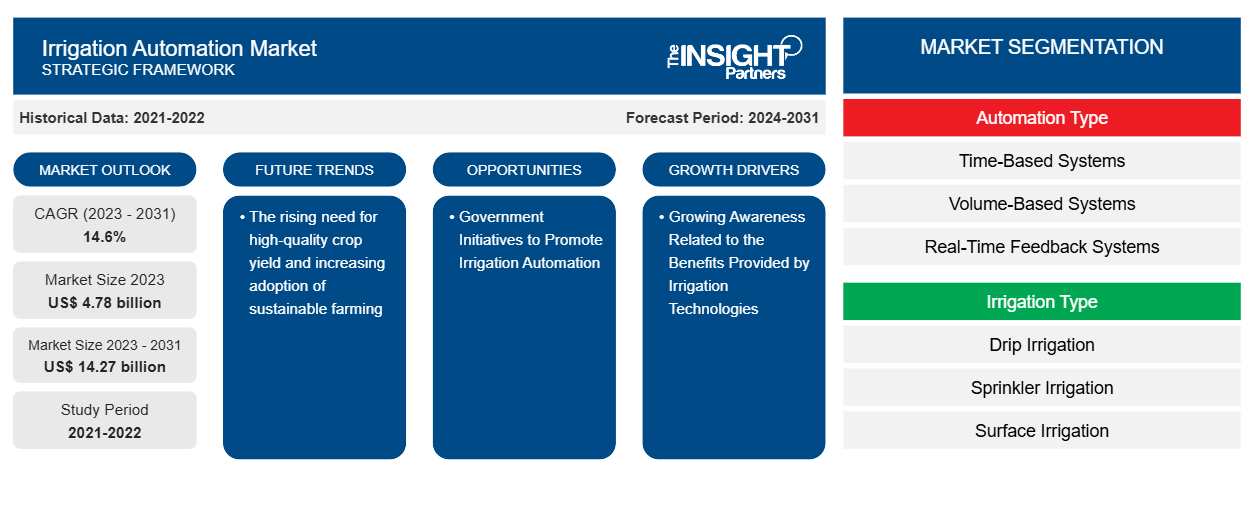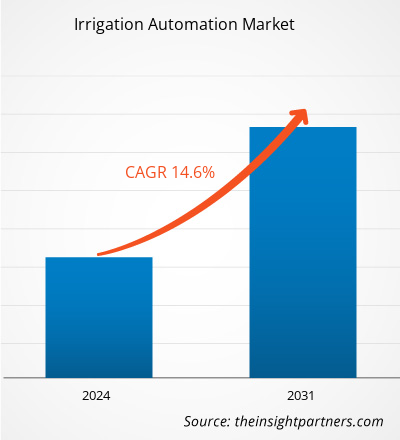The irrigation automation market size is projected to reach US$ 14.27 billion by 2031 from US$ 4.78 billion in 2023. The market is expected to register a CAGR of 14.6% in 2023–2031. The rising need for high-quality crop yield and increasing adoption of sustainable farming is likely to remain a key irrigation automation market trend.
Irrigation Automation Market Analysis
The irrigation automation market is growing at a rapid pace due to the growing awareness related to the benefits provided by irrigation technologies and the acceptance of precise agriculture instruments and techniques. The market is expanding steadily, driven by the growing demand for smart agriculture technologies. Moreover, technological advancements and government initiatives to promote irrigation automation are providing lucrative opportunities for market growth.
Irrigation Automation Market Overview
Irrigation automation uses instruments or equipment to operate various irrigation systems and alter the flow of water from bays. Irrigation automation includes the combination of numerous hardware, such as sensors, valves, controllers, sprinklers, and others, to build an automated system used for both agricultural and non-agricultural applications. Significant benefits provided by irrigation automation, such as time-saving, cost-effectiveness, resource optimization, and others, are driving the market.
Customize This Report To Suit Your Requirement
You will get customization on any report - free of charge - including parts of this report, or country-level analysis, Excel Data pack, as well as avail great offers and discounts for start-ups & universities
Irrigation Automation Market: Strategic Insights

-
Get Top Key Market Trends of this report.This FREE sample will include data analysis, ranging from market trends to estimates and forecasts.
Irrigation Automation Market Drivers and Opportunities
Growing Awareness Related to the Benefits Provided by Irrigation Technologies is Driving the Market
Farmers are becoming more aware of automated irrigation technologies associated with the high labor and electricity costs. Irrigation technologies provide significant benefits to the users, such as water conservation, process automation, and cost-saving, among others are driving the market. These benefits increase awareness among farmers, which surges the adoption of irrigation technologies. These technologies support farmers in decreasing daily electricity use, as well as reducing in time and effort spent on irrigation. Moreover, farmers were able to reduce the amount of farm trips through automation, resulting in lower labor expenditures. The installation of an automated irrigation system improves agricultural precision by determining the exact volume of water and irrigation time. This precision reduces crop losses for farmers and boosts total productivity.
Government Initiatives to Promote Irrigation Automation – An Opportunity in the Irrigation Automation Market
The majority of farmers in underdeveloped nations employ conventional irrigation systems (surface irrigation), which is a time-consuming process. This encourages the governments of various nations to take favorable initiatives to promote irrigation automation, which is expected to create opportunities in the market. Many governments in developing nations such as India, China, Brazil, the US, France, and other African countries offer grants for the purchase of drip and sprinkler systems in order to increase the efficiency of their irrigation systems. Moreover, strict policies that encourage the use of sprinkler and drip irrigation systems help farmers to adopt technologically developed systems on their farms, such as acquiring and reinstalling farm irrigation devices (sprinklers and drip irrigation systems). These factors are creating significant growth opportunities for the market during the forecast period.
Irrigation Automation Market Report Segmentation Analysis
Key segments that contributed to the derivation of the irrigation automation market analysis are automation type, irrigation type, component, system, and end-user.
- Based on automation type, the market is divided time-based systems, volume-based systems, real-time feedback systems, and computer-based irrigation control systems. The time-based systems segment held a larger market share in 2023.
- On the basis of irrigation type, the market is divided into drip irrigation, sprinkler irrigation, and surface irrigation. The drip irrigation segment held a larger market share in 2023.
- In terms of component, the market is segmented into controllers, sensors, valves, sprinklers, and others. The controllers segment held a larger market share in 2023.
- Based on system, the irrigation automation market is divided automatic and semiautomatic. The automatic segment held a larger market share in 2023.
- In terms of end-uses, the market is categorized as agricultural and non-agricultural. The agricultural segment held a larger market share in 2023.
Irrigation Automation Market Share Analysis by Geography
The geographic scope of the irrigation automation market report is mainly divided into five regions: North America, Asia Pacific, Europe, Middle East & Africa, and South America/South & Central America.
In terms of revenue, Asia Pacific accounted for the largest irrigation automation market share, due to the presence of vast agricultural land and favorable government support. The market is anticipated to expand in the near future, attributed to rapid changes in climate conditions and the growing need for reducing waste wastage. Moreover, technological advancements and the development of advanced irrigation systems are boosting the market during the forecast period.
Irrigation Automation Market Regional InsightsThe regional trends and factors influencing the Irrigation Automation Market throughout the forecast period have been thoroughly explained by the analysts at The Insight Partners. This section also discusses Irrigation Automation Market segments and geography across North America, Europe, Asia Pacific, Middle East and Africa, and South and Central America.
Irrigation Automation Market Report Scope
| Report Attribute | Details |
|---|---|
| Market size in 2023 | US$ 4.78 billion |
| Market Size by 2031 | US$ 14.27 billion |
| Global CAGR (2023 - 2031) | 14.6% |
| Historical Data | 2021-2022 |
| Forecast period | 2024-2031 |
| Segments Covered |
By Automation Type
|
| Regions and Countries Covered |
North America
|
| Market leaders and key company profiles |
|
Irrigation Automation Market Players Density: Understanding Its Impact on Business Dynamics
The Irrigation Automation Market is growing rapidly, driven by increasing end-user demand due to factors such as evolving consumer preferences, technological advancements, and greater awareness of the product's benefits. As demand rises, businesses are expanding their offerings, innovating to meet consumer needs, and capitalizing on emerging trends, which further fuels market growth.

- Get the Irrigation Automation Market top key players overview
Irrigation Automation Market News and Recent Developments
The irrigation automation market is evaluated by gathering qualitative and quantitative data post primary and secondary research, which includes important corporate publications, association data, and databases. The following is a list of developments in the market for irrigation automation and strategies:
- In March 2024, Rubicon Water shares its latest project on the Uzbekistan-Tajikistan border. Supported by the Swiss Cooperation Office and the Blue Peace Initiative, this innovative project focuses on cross-border distribution and measurement to promote collaboration in transboundary water management. In addition to improving water management for irrigation, Rubicon’s technology is playing an increasingly crucial role in groundwater management, recharge programs, and environmental flow initiatives, contributing to the preservation of vital water resources and ecosystems. (Source: Rubicon Water, Press Release, 2024)
Irrigation Automation Market Report Coverage and Deliverables
The “Irrigation Automation Market Size and Forecast (2021–2031)” report provides a detailed analysis of the market covering below areas:
- Market size and forecast at global, regional, and country levels for all the key market segments covered under the scope
- Market dynamics such as drivers, restraints, and key opportunities
- Key future trends
- Detailed PEST/Porter’s Five Forces and SWOT analysis
- Global and regional market analysis covering key market trends, major players, regulations, and recent market developments
- Industry landscape and competition analysis covering market concentration, heat map analysis, prominent players, and recent developments
- Detailed company profiles
Frequently Asked Questions
What is the estimated market size for the global irrigation automation market in 2023?
What are the driving factors impacting the global irrigation automation market?
What are the future trends of the global irrigation automation market?
Which are the key players holding the major market share of the global irrigation automation market?
What will be the market size of the global irrigation automation market by 2031?
What is the incremental growth of the global irrigation automation market during the forecast period?
- Historical Analysis (2 Years), Base Year, Forecast (7 Years) with CAGR
- PEST and SWOT Analysis
- Market Size Value / Volume - Global, Regional, Country
- Industry and Competitive Landscape
- Excel Dataset
Recent Reports
Testimonials
Reason to Buy
- Informed Decision-Making
- Understanding Market Dynamics
- Competitive Analysis
- Identifying Emerging Markets
- Customer Insights
- Market Forecasts
- Risk Mitigation
- Boosting Operational Efficiency
- Strategic Planning
- Investment Justification
- Tracking Industry Innovations
- Aligning with Regulatory Trends





















 Get Free Sample For
Get Free Sample For